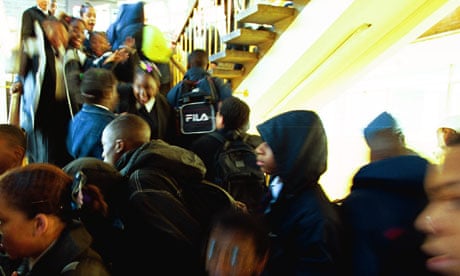England's state schools are far more ethnically diverse than they were five years ago, with almost a quarter of all pupils in primary and secondaries from an ethnic minority, official statistics show.
Some 24.3% of pupils in state primaries and secondaries are from an ethnic minority, according to figures collected in January and published by the Department for Education (DfE). Five years ago, the proportion was 19.8%.
In primary schools, 26.5% of pupils are from an ethnic minority, compared with 21.9% five years ago. In secondaries, 22.2% of pupils are from an ethnic minority, compared with 17.7% five years ago.
The statistics, taken from the School Census and surveys completed by local authorities, show the proportion of pupils whose first language is not English has risen to 16.8% in primary schools, from 13.5% five years ago.
In secondaries, the proportion of pupils whose first language is not English is 12.3%, compared with 10.5% five years ago. In the east London boroughs of Tower Hamlets and Newham, the proportion of primary school pupils whose first language is not English is 78% and 74% respectively.
A spokesman from the DfE said that pupils whose mother tongue was not English did not necessarily have poor English skills. "The evidence is clear that once English is established, children catch up and even overtake their peers," he said.
Ethnic minorities will make up a fifth of Britain's population by 2051, compared with 8% in 2001, according to projections published by the University of Leeds.
Some 121,420 more pupils in state schools are eligible for and claiming free school meals than five years ago, the figures also show. Around 18% of pupils now claim free school meals, compared with 16% in 2007. In nursery and primary schools, the figure is almost one in five – 19.2% – while in secondaries it is 15.9%. Local authorities that are offering all pupils free school meals as part of a pilot project only included those pupils who are currently eligible for the benefit.
Meanwhile, separate figures show the number of parents who appealed to get their child into their preferred state primary school last year grew by 10.5% on the year before.
Some 42,070 parents appealed against their local authority's decision, compared with 38,080 the year before. This means that just over five in every 100 primary school places were contested. The number of primary school appeals has doubled in the last four years.
Demand for places has soared because of a baby boom. Some parents, to save money, have also changed their minds about sending their children to private schools.
The number of parents who appealed because their child did not get into their preferred secondary school fell to 43,095 last year, from 50,195 the year before. However, the statisticians did not include the growing number of academy schools.
The proportion of parents who were successful in their appeals against a primary school allocation dropped to 24.5% from 25% the year before. But the proportion who were successful in their appeals against a secondary school allocation rose to 34.4%, from 33.3% the year before.
The School Census statistics also reveal that more than 8,000 children aged five and six are being taught in classes that are above the legal limit. In 2001, it became illegal for primary schools to teach children under eight years old in classes of more than 30 pupils, other than in exceptional circumstances.
Some 310 classes for five and six year olds were above the legal limit, compared with 130 five years ago. Overall, the average class size for this age group has risen to 26.9 pupils, from 25.6 in 2007. Overall, the average class size in state primaries has gone up to 26.6 pupils, compared with 26.2 five years ago, but the average class size in a state secondary has gone down to 20.4 from 21.2 in the same period.

Comments (…)
Sign in or create your Guardian account to join the discussion